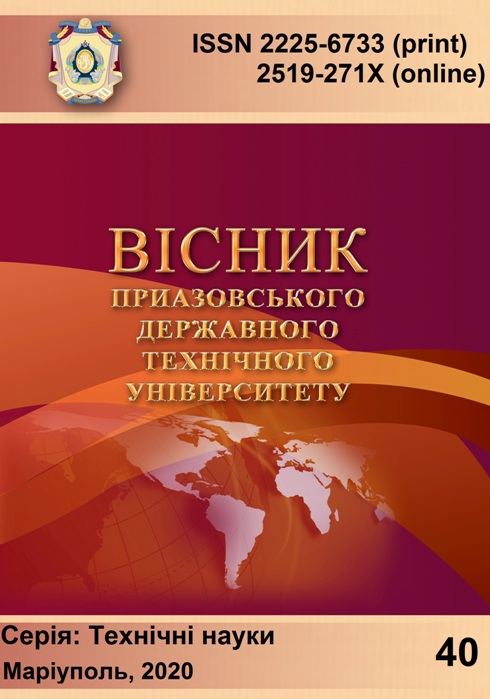Microstructure and elemental analysis of powder iron-based composite materials
DOI:
https://doi.org/10.31498/2225-6733.40.2020.216169Keywords:
structure, ironbronza phase, powdered composition, the liquid sintering, the porosity, non-metallic phases, perlite, braking, verd particlesAbstract
This article studies the kinetics of structure formation of a composite powder material containing solid lubricants such as graphite, talc and zinc stearate. For the experiments were prepared charge containing powders, wt.%: Cu – 4-18; Sn – 1-2.0; C – 1.5-2.5;talc – 2.0-3.5; zinc stearate – 0.5, Fe – the rest. Mixing of powders was carried out in a Y-shaped mixer, pressing of charges was carried out on a hydraulic press at pressures of 400-1000 MPa, and sintering of compacts – in a conveyor furnace in a protective gas (endothermic gas) in the temperature range 850-1150°C. There is no pearlite in the microstructure of iron-bronze sintered at 850°C. This is due to the adsorption capacity of talc on the surface of iron particles, which prevents the diffusion of carbon into the iron crystal lattice. An increase in the sintering temperature to 1000°C leads to the formation of pearlite in the structure of iron-bronze, while pearlite prevails over ferrite. This indicates the partial burnout of talc from the surface of the iron particles and the open paths of carbon diffusion. At a sintering temperature of 1150°C, a pearlite structure and a network of light inclusions are formed in the microstructure of iron-bronze samples. The study of the chemical composition of light inclusions with a micro-X-ray spectral analyzer showed that these inclusions contain solid solutions of variable compositions either Fe-Cu-Sn, Cu-Fe-Sn or Cu-Sn-Fe. To confirm these assumptions, X-ray phase analysis was performed. The diffraction patterns of these samples are reflections of Fe and Cu. The absence of diffraction effects characteristic of Sn is due to its solubility in the Cu lattice. This is due to the low melting point of Sn (232°С) and its ionic radius, which allows the isomorphic substitution of Cu and Fe ions with Sn ions (their difference is no more than 15%)
References
References:
Ermakov S.S., Ermakov B.S. Vliianie zhidkoi fazy na formirovanie struktury spechennykh splavov. Materialy IV Vsesoiuznoi nauch.-tekhn. konf. «Goriachee pressovanie v poroshkovoi metallurgii» [Influence of the liquid phase on the formation of the structure of sintered alloys. Proceedings of IV All-Union Sci.-Tech. Conf. «Hot pressing in powder metallurgy»]. Novocherkassk, 1991, pp. 85-88. (Rus.)
Mamedov A.T. Konstruktsionnye i antifriktsionnye poroshkovye materialy [Structural and anti-friction powder materials]. Baku, Elm Publ., 2005. 458 p. (Rus.)
Перелік використаних джерел (ДСТУ):
Ермаков С.С. Влияние жидкой фазы на формирование структуры спеченных сплавов / С.С. Ермаков, Б.С. Ермаков / Горячее прессование в порошковой металлургии : материалы IV Всесоюзной научно-технической конференции. – Новочеркасск, 1991. – С. 85-88.
Мамедов А.Т. Конструкционные и антифрикционные порошковые материалы / А.Т. Мамедов. – Баку : Элм, 2005. – 458 с.
Downloads
How to Cite
Issue
Section
License
Journal "Reporter of the Priazovskyi State Technical University. Section: Technical sciences" is published under license CC-BY (License "Attribution").This license allows you to distribute, edit, correct and take work as a basis for derivatives, even on a commercial basis with an indication of authorship. It is the most convenient of all the proposed license. Recommended for maximum dissemination and use of licensed materials.

Authors who publish in this journal agree to the following terms:
1. The authors reserve the right to authorship of his work and pass the journal right of first publication of the work under the terms of Creative Commons Attribution License, which allows others to freely distribute the work published with the obligatory reference to the authors of the original work and the first publication of the work in this journal.
2. The authors have the right to enter into separate supplemental agreements relating to the non-exclusive dissemination of works in the form in which it was published in the journal (for example, to place the work in the institution, or to publish a monograph as part of an electronic store), while maintaining links to the first publication of the work in this magazine.








